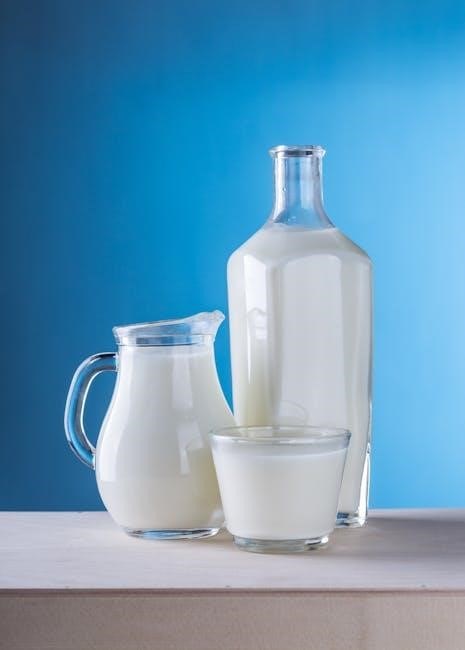The primary distinction between A1 and A2 milk lies in the 67th amino acid of beta-casein, impacting digestion and health. A2 milk contains proline, while A1 has histidine, potentially affecting BCM-7 production. This difference has sparked consumer interest in A2 milk due to its perceived digestive benefits.
Overview of A1 and A2 Milk Types
A1 and A2 milk differ primarily in the amino acid at position 67 of the beta-casein protein. A2 milk contains proline, while A1 milk has histidine. This variation influences digestion and potential health effects. A2 milk is considered closer to natural milk, as A1 milk arose from a genetic mutation in European cattle. A2 milk is often associated with better digestibility and reduced symptoms like bloating, while A1 milk may produce BCM-7, a peptide linked to health concerns. Research continues to explore these differences and their implications for human health.
Importance of Understanding Milk Variants
Understanding A1 and A2 milk variants is crucial for consumers to make informed choices about their health and nutrition. The distinction between these milks lies in their beta-casein protein structure, which affects digestion and potential health outcomes. Recognizing these differences helps consumers align their dietary preferences with personal health needs, promoting better digestibility, and reducing adverse reactions. This awareness also empowers individuals to navigate the growing market of specialized dairy products effectively, ensuring they select options that best suit their lifestyles and well-being.

What is A1 Milk?
A1 milk contains the A1 variant of beta-casein, characterized by a histidine amino acid at position 67. It is linked to the production of BCM-7, a peptide associated with potential health concerns.
Definition and Origin of A1 Milk
A1 milk is defined by the presence of a histidine amino acid at position 67 of the beta-casein protein. Originating from a genetic mutation in European cattle, A1 milk differs from A2 milk, which contains proline at the same position. This mutation occurred thousands of years ago, leading to the widespread prevalence of A1 milk in modern dairy products. The genetic variation affects how the milk is digested, with A1 milk producing the peptide BCM-7 during digestion, which has been linked to various health concerns in some studies.
Genetic Factors Behind A1 Milk
The production of A1 milk is determined by a specific mutation in the CSN2 gene, which codes for beta-casein. This mutation results in histidine being present at position 67 of the protein chain. The mutation is believed to have occurred in European cattle thousands of years ago, leading to the prevalence of A1 milk in modern dairy products. This genetic variation influences how the milk is digested, with A1 milk producing the peptide BCM-7, which has been associated with various health issues in some individuals. Understanding these genetic factors is crucial for grasping the differences between A1 and A2 milk.

What is A2 Milk?
A2 milk is defined as containing over 99% beta-casein in the A2 type, considered the original form before the mutation that led to A1 milk.
Definition and Origin of A2 Milk
A2 milk is defined as milk containing predominantly A2 beta-casein, with over 99% of the beta-casein in the A2 form. Originating from a natural genetic variation, A2 milk is closer to the original milk produced by cows before the A1 mutation occurred in European cattle. This type of milk is often associated with easier digestion and reduced gastrointestinal discomfort compared to A1 milk. The A2 variant is considered the ancestral form, aligning more closely with human beta-casein, which may contribute to its perceived health benefits. Its origin traces back to ancestral cattle breeds, emphasizing its natural, unchanged state.
Genetic Factors Behind A2 Milk
The genetic variation responsible for A2 milk lies in the beta-casein protein, encoded by the CSN2 gene on chromosome 6 in cows. A2 milk is characterized by a proline residue at position 67 of the beta-casein chain, distinguishing it from A1 milk, which has a histidine residue. This genetic difference arises from natural variations in cattle breeds, with A2 being the ancestral form before the A1 mutation occurred in European herds. The A2 variant is associated with specific dairy breeds, such as Guernsey and Jersey cows, and is linked to improved digestibility and reduced health concerns compared to A1 milk.

Key Differences Between A1 and A2 Milk
The primary distinction is the amino acid at position 67 in beta-casein: A1 milk contains histidine, while A2 milk contains proline. This variation influences digestion and health outcomes.
Amino Acid Variation at Position 67
The key difference between A1 and A2 milk lies in the amino acid at position 67 of the beta-casein protein. A1 milk contains histidine, while A2 milk contains proline. This variation significantly impacts how the protein is digested. In A1 milk, the histidine residue can lead to the release of a peptide called BCM-7 during digestion, which has been linked to various health concerns. In contrast, the proline in A2 milk prevents the formation of BCM-7, making it easier to digest and potentially healthier for some individuals. This amino acid difference is central to the debate surrounding A1 and A2 milk.
Role of Beta-Casein in Milk
Beta-casein is a key protein in milk, accounting for approximately 30% of total casein proteins. Its primary role is to transport essential minerals like calcium and phosphorus, enhancing their absorption in the digestive system. The structure of beta-casein, particularly at position 67, influences its digestion and the release of bioactive peptides. This protein plays a critical role in both the nutritional and physiological effects of milk, with variations like A1 and A2 impacting how it is processed by the body. Understanding beta-casein’s function is essential for evaluating the differences between A1 and A2 milk.

Health Implications of A1 and A2 Milk
A1 milk may release BCM-7, potentially linked to digestive discomfort and chronic diseases, while A2 milk is often easier to digest and associated with fewer health risks.
BCM-7 and Its Effects on Health
BCM-7, a peptide released during digestion of A1 milk, has been linked to potential health issues. Studies suggest it may contribute to gastrointestinal discomfort, inflammation, and conditions like heart disease and diabetes. BCM-7 is absent in A2 milk due to the proline amino acid, which prevents its formation. This difference has led some researchers to associate A1 milk with adverse health effects, though more studies are needed to confirm these findings and establish definitive conclusions about its impact on human health.
Digestibility and Gastrointestinal Impact
The digestibility of A1 and A2 milk differs due to the presence of BCM-7 in A1 milk. BCM-7, a bioactive peptide, may cause gastrointestinal discomfort in some individuals. A2 milk, lacking BCM-7, is often tolerated better, reducing symptoms like bloating and abdominal pain. Studies suggest that A2 milk’s proline at position 67 prevents BCM-7 formation, making it a preferable choice for those with sensitivities. This distinction highlights A2 milk’s potential benefits for digestive health.

Market Trends and Consumer Preferences
Rising demand for A2 milk is driven by its perceived health benefits, with consumers willing to pay premium prices. A1 milk remains more widely available, but A2 gains traction.
Rising Popularity of A2 Milk
A2 milk’s popularity is growing due to its perceived health benefits and easier digestibility compared to A1 milk. Consumers increasingly seek dairy products aligned with their wellness goals. Studies suggesting A2 milk causes fewer digestive issues have fueled demand. Its premium pricing reflects consumer willingness to pay for perceived health advantages. Additionally, marketing campaigns highlighting A2 milk’s natural origins and potential benefits have contributed to its mainstream acceptance. This shift underscores a broader trend toward specialized, health-focused dairy products catering to evolving consumer preferences and dietary needs.
Labeling and Certification of A2 Milk
A2 milk is defined as containing above 99% beta-casein in the A2 type, distinguishing it from A1 milk. Certification ensures A2 milk meets strict standards, verifying the absence of A1 beta-casein. Labeling emphasizes this difference, helping consumers identify A2 milk as a premium, specialized product. Regulatory bodies oversee testing to confirm milk’s A2 status, ensuring transparency and quality. This certification process builds trust and differentiation in the market, allowing consumers to make informed choices aligned with their health and dietary preferences.

Scientific Debate and Research
Research on A1 and A2 milk focuses on their amino acid differences and health implications, with studies examining digestion, BCM-7 effects, and potential links to chronic diseases, sparking ongoing debate.
Studies Comparing A1 and A2 Milk
Research comparing A1 and A2 milk has focused on their amino acid differences and health effects. A study involving 41 healthy adults found that A2 milk caused significantly less abdominal pain and bloating compared to A1 milk. Another study in rabbits explored the impact of A1 and A2 proteins on health outcomes, though no direct link to type 1 diabetes was established. These studies highlight the potential benefits of A2 milk for digestion and suggest further investigation into long-term health implications. More research is needed to confirm these findings.
Criticisms and Controversies in the Debate
The debate over A1 and A2 milk has sparked criticism, with some arguing that the evidence linking A1 milk to health issues like diabetes or autism is inconclusive. Critics highlight that many studies are small-scale or funded by companies promoting A2 milk, raising concerns about bias. Additionally, the marketing of A2 milk as a premium product has been questioned, as its benefits are not universally accepted by the scientific community. These controversies underscore the need for larger, independent studies to validate claims and provide clearer guidance for consumers.

Nutritional Comparison
A1 and A2 milk share similar nutritional profiles, differing mainly in the amino acid at position 67 of beta-casein. Both contain essential proteins, calcium, and phosphorus, but the variation in beta-casein affects how these nutrients are transported and absorbed, with A2 milk potentially offering better bioavailability for some individuals.
Protein Content and Nutrient Absorption
A1 and A2 milk contain similar protein levels, but differences in beta-casein structure affect nutrient absorption. A2 milk, with proline at position 67, may enhance mineral transport, like calcium and phosphorus, due to its stable binding properties. In contrast, A1 milk’s histidine at the same position can release BCM-7 during digestion, potentially slowing nutrient uptake. While both milks provide essential nutrients, A2 milk’s beta-casein structure may offer better bioavailability, making it a preferred choice for individuals seeking optimal nutritional benefits from dairy products.
Mineral Transport and Bioavailability
A2 milk’s beta-casein structure, with proline at position 67, enhances mineral transport by forming stable bonds with calcium and phosphorus, improving bioavailability. In contrast, A1 milk’s histidine at the same position may reduce mineral-binding efficiency due to the release of BCM-7, which can interfere with nutrient absorption. This structural difference in beta-casein significantly impacts how effectively minerals are transported and utilized by the body, making A2 milk potentially more advantageous for optimal mineral intake and overall health benefits compared to A1 milk.

Historical and Evolutionary Context
A2 milk is believed to be the original form, with A1 milk emerging from a mutation in European cattle around 8,000 years ago, shaping dairy evolution.
Origins of A1 and A2 Milk Variants
A2 milk is believed to be the ancestral form, while A1 milk arose from a genetic mutation in European cattle around 8,000 years ago. This mutation introduced histidine at the 67th amino acid position in beta-casein, distinguishing A1 milk. Historically, A2 milk was predominant in regions like Africa and Asia, whereas A1 milk became widespread in Europe. This evolutionary shift influenced the global distribution of milk types, contributing to the diversity of dairy products consumed today.
Evolutionary Shifts in Milk Consumption
Historically, A2 milk was the predominant form consumed by humans, aligning with the natural beta-casein structure in early cattle. The shift toward A1 milk occurred with agricultural advancements and cattle domestication in Europe. Over time, A1 milk became prevalent in Western diets due to its dominance in European herds. However, recent consumer trends show a resurgence of interest in A2 milk, driven by its perceived health benefits and digestibility. This reflects an evolutionary shift in milk consumption, influenced by both genetic changes in cattle and evolving human preferences.
Economic and Environmental Impact
The shift toward A2 milk production influences dairy economics, with higher production costs for specialized herds. Its premium pricing impacts market dynamics and sustainability practices.
Production Costs and Market Dynamics
Producing A2 milk involves higher costs due to the need for specialized herds and genetic testing. This exclusivity allows for premium pricing, impacting market competition. As consumer demand grows, driven by perceived health benefits, dairy companies invest in A2-specific production and marketing. The premium nature of A2 milk creates a niche market, influencing pricing strategies and profit margins for producers. This dynamic shifts the economic landscape, favoring those who can meet the growing consumer preference for A2 products.
Sustainability of A2 Milk Production
A2 milk production’s sustainability is influenced by resource use and environmental impact. The need for specific cow breeds and genetic testing can increase costs and resource demand. However, as consumer demand grows, economies of scale may enhance sustainability. Ethical considerations, such as animal welfare and waste management, also play a role. While A2 milk’s niche status currently limits its environmental efficiency, advancements in production and certification processes aim to balance sustainability with consumer preferences for healthier dairy options.

Consumer Education and Awareness
Understanding A1 and A2 milk labels is crucial for informed choices, empowering consumers to align their dietary preferences with health and digestive needs effectively.
Understanding Labels and Claims
Understanding the labels on A1 and A2 milk is essential for making informed decisions. A1 milk contains histidine at the 67th amino acid, while A2 milk has proline. This difference impacts digestion and health claims, as A1 milk may produce BCM-7, a peptide linked to digestive discomfort. Labels often highlight A2 milk as “A2-only” or “contains only A2 protein,” ensuring it meets specific criteria, like containing at least 99% A2 beta-casein. Clear labeling helps consumers choose based on their health preferences and digestive needs, promoting transparency in dairy products.
Making Informed Choices About Milk
Making informed choices about milk involves understanding its nutritional and health implications. A2 milk is often preferred for its easier digestibility, as it lacks the BCM-7 peptide found in A1 milk, which may cause discomfort. Both types provide similar nutritional benefits, but the protein structure differs. Consumers should consider their health needs, digestive sensitivity, and lifestyle preferences when selecting milk. Moderation and variety are key to a balanced diet, allowing individuals to choose the milk that best suits their personal well-being and dietary goals.
The choice between A1 and A2 milk depends on individual health needs and digestive comfort. Both offer similar nutrition, but A2 may suit sensitive digesters better. Always opt for informed decisions based on personal health requirements and professional advice to make the best choice for your well-being.
Future of A1 and A2 Milk in the Dairy Industry
The dairy industry is likely to see a continued rise in A2 milk popularity due to its perceived health benefits and better digestibility. As consumer awareness grows, demand for A2 milk may drive shifts in cattle breeding practices, favoring A2-producing herds. Meanwhile, A1 milk may remain dominant in regions where its production is well-established. The industry could also witness advancements in labeling and certification to differentiate A2 products, ensuring transparency for consumers. This evolution reflects broader trends toward personalized nutrition and health-focused food choices.
Final Thoughts on Milk Selection
Choosing between A1 and A2 milk depends on individual health needs and digestive sensitivities. A2 milk may offer better digestibility for some, potentially reducing discomfort. However, for many, A1 milk remains a nutritious choice without adverse effects. Personal preferences, lifestyle, and medical advice should guide decisions. Both types provide essential nutrients, but understanding their differences can help consumers make informed choices aligned with their well-being. Balancing scientific insights with personal experiences is key to selecting the most suitable milk option.